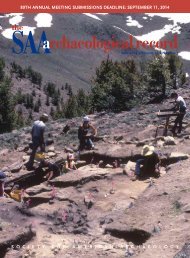SAA
Nov2016_web
Nov2016_web
Create successful ePaper yourself
Turn your PDF publications into a flip-book with our unique Google optimized e-Paper software.
VIDEO GAMES AND ARCHAEOLOGY<br />
Archaeological research is not restricted to virtual spaces that<br />
are copies or representations of real sites. Indeed, it can be<br />
equally valuable to conduct archaeological modeling or to<br />
test hypotheses in fictional spaces. For instance, World of<br />
Warcraft is an MMORPG set in an extensive world with a<br />
large player base. 8 The large number of players, as well as the<br />
complex spaces that they engage in, have provided suitable<br />
conditions for many research projects in the fields of sociology<br />
(Bainbridge 2010), ethnography, and even epidemiology<br />
(Balicer 2005). Video games could prove to be a fertile environment<br />
for archaeological theory testing, for instance into<br />
human interaction with space or exchange networks (Mol<br />
2014).<br />
Conclusion<br />
This article began by showcasing the results from a small<br />
survey about archaeology and video games conducted at Leiden<br />
University’s Faculty of Archaeology. Through this survey,<br />
we were able to observe a paradox in the attitudes of archaeologists<br />
toward video games and their inclusion of archaeological<br />
elements. While the respondents enjoyed archaeology<br />
in these games, they did not find it particularly important.<br />
They noted a number of explanations for this, ranging from<br />
problems of accuracy to a lack of excitement.<br />
The aforementioned examples are only some of a large number<br />
of current practices and developments taking place in the<br />
intersection of archaeology and gaming. They provide a<br />
glimpse of the value this field may hold for education,<br />
research, and society. This potential is currently held back by<br />
the general niche status of gaming as a serious topic to be<br />
tackled by (dedicated) archaeological professionals. On the<br />
other side of the spectrum, well-willing developers often<br />
have no access to archaeological resources and professional<br />
networks, effectively requiring them to explore the archaeological<br />
profession or the period their games take place in by<br />
themselves. In sum, we feel that closer collaborations<br />
between game developers and archaeologists are needed if<br />
video games and archaeology are to be of greater mutual<br />
value. Collaborations will increase public outreach of archaeology<br />
as well as provide new avenues for archaeological<br />
research. At the same time it will enrich video game development<br />
by creating a deeper and more accurate immersion<br />
into the past.<br />
References Cited<br />
Bainbridge, William Sims<br />
2010 The Warcraft Civilization: Social Science in a Virtual World.<br />
MIT Press, Cambridge.<br />
Balicer, Ran<br />
2005 Modeling Infectious Diseases Dissemination through<br />
Online Role-Playing Games. Epidemiology 18:260–261.<br />
Lowe, Dunstan<br />
2013 Always Already Ancient: Ruins in the Virtual World. In<br />
Greek and Roman Games in the Computer Age, edited by Thea S.<br />
Thorsen, pp. 53–90. Fagbokforlaget, Trondheim.<br />
Mol, Angus<br />
2014 Play-Things and the Origins of Online Networks: Virtual<br />
Material Culture in Multiplayer Games. Archaeological Review<br />
from Cambridge 29:144–166.<br />
Morgan, Colleen L.<br />
2009 (Re)Building Çatalhöyük: Changing Virtual Reality in<br />
Archaeology. Archaeologies 5(3):468–487.<br />
Roy, Gilles<br />
2015 APOTHEON: The Action Hero at the Heart of Greek<br />
Myth. February 18, 2015. Play the Past. Electronic document,<br />
http://www.playthepast.org/?p=5104, accessed September 21,<br />
2015.<br />
Tate<br />
2014 Tate Creates Minecraft Worlds Inspired by Art. November<br />
17, 2014. Tate. Electronic document, http://www.tate.org.uk/<br />
context-comment/articles/tate-worlds-minecraft, accessed September<br />
21, 2015.<br />
Notes<br />
1. The questionnaire can be found on VALUE’s website:<br />
http://www.valueproject.nl/wp-content/uploads/2015/10/Surveysemi-final-draft.pdf.<br />
2. Question 6: “What do you enjoy most in a video game?” The<br />
respondents could choose multiple answers. The percentage refers<br />
to the amount of respondents who selected this aspect out of the<br />
total number of people who answered this question.<br />
3. These aspects may refer to archaeology as a subject, archaeology<br />
as a profession, archaeological interpretations, or anything else<br />
the respondents considered.<br />
4. Question 10: “Do you think archaeology in video games is<br />
representative of actual archaeology? Why?”<br />
5. You can find our play-through of the game with commentary<br />
here: https://www.youtube.com/playlist?list=PLKbRwyeu6RQ<br />
v7cFpaSAF0u7pOGRvaR-0j.<br />
6. You can see the developing project, or sign up to participate,<br />
on their tumblr: http://museumcraft.tumblr.com/.<br />
7. An extensive write-up of this event can be found on VALUE’s<br />
website: http://www.valueproject.nl/blog-posts/streaming-thepast/recap-of-the-palmyra-re-construction/.<br />
8. Currently, the game has 5.6 million subscribers globally. At<br />
its height in 2010, 12 million people were subscribed to World of<br />
Warcraft, http://www.statista.com/statistics/276601/number-ofworld-of-warcraft-subscribers-by-quarter/.<br />
November 2016 • The <strong>SAA</strong> Archaeological Record<br />
15




